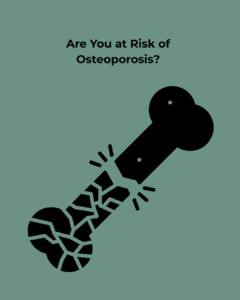Are You at Risk of Osteoporosis? Know Your Numbers
Osteoporosis is often called the silent disease, because you don’t feel your bones weakening—until they break.
But there are clear risk factors that increase your chances of developing osteoporosis. Knowing these helps you take action early and prevent fractures.
📉 What is Osteoporosis?
Osteoporosis means “porous bones.”
Your bones lose density and strength, becoming brittle and fragile. Even a minor fall or bump can cause a fracture.
Osteoporosis is most common in:
- Women after menopause. Osteoporosis accounts for more days in hospital than many other diseases such as diabetes, heart attack and breast cancer.
- People over 50, men as well as women.
- Anyone with a family history of fractures
🔍 Top Risk Factors for Osteoporosis
✅ Age: Over 50 for women, over 60 for men
✅ Family history of osteoporosis or fractures
✅ Smoking & excessive alcohol
✅ Long-term use of steroids (like prednisone)
✅ Early menopause (before age 45)
✅ Low body weight or eating disorders
✅ Lack of weight-bearing exercise
✅ Chronic conditions like diabetes or thyroid disorders
✅Low Calcium intake - requirements vary according to age
✅Low Vitamin D - sun exposure levels can be checked on a sunshine map
If you tick more than one of these boxes, it’s time to check your bone health.
Fixed Risks - are factors that cannot be changed but we need to be aware of them. It just increases the obvious need to minimize bone density loss at any age. (Low bone mass is considered a Fixed and Modifiable risk factor since it has so many factors that come into play).
- Age - 90% of hip fractures occur after 50.
- Height Loss - men or women with an annual height loss > 0.5cm are at increased risk of any fracture including hip.
- Female - the estrogen loss after menopause means increased bone loss. Lifetime fracture ranges are 40 - 50% for women and 13 - 22% for men. Big difference.
- Family History of Osteoporosis
- Previous Fracture - It has been found that following their first fragility fracture, the risk of a subsequent fracture in women 50 - 80 jumps by 500%.
- Ethnicity - Osteoporosis is more common in Caucasian and Asian populations.
- Estrogen deficiency and amenorrhea - if you suffer these as a younger women you limit the peak bone density of your bones and so are more vulnerable when menopause arrives.
- Menopause and Hysterectomy with ovary loss - estrogen reduction and associated bone loss.
Modifiable Risks - factors of bone density loss that are influenced by factors that can be altered.
- Alcohol - Above 2 units per day is considered a threshold for an increased risk due to its impact on bone-forming cells.
- Smoking - leads to lower bone density.
- Low Body Mass Index - A BMI less than 20 is associated with greater bone mass loss.
- Low Calcium intake - the bone can be sacrificed to provide calcium essential for operation of muscles and nerves.
- Vitamin D deficiency - Vit D is essential for the uptake of calcium from the intestines into the blood.
- Eating Disorders - anorexia nervosa and bulimia are noted for their effect on bone mass since they typically start to appear in adolescence when bones are still in the maturation phase.
- Sedentary Lifestyle - the skeletal system responds to load so a lot of sitting means less bone construction.
- Falls - The risk of falls increases with age with weaker muscles, poor balance, cognition loss and use of medications as common causes.
🩺 How to Check Your Bone Density
DEXA Scan
The gold-standard test for measuring bone mineral density (BMD).
Painless and quick, it shows if you have normal bone density, osteopenia (early bone loss), or osteoporosis.
Chiropractic Postural & Spinal Check
We can pick up early signs of bone loss, such as:
- Height loss
- Stooped posture
- Spinal compression
- Fragility in load-bearing joints
🧠 Why Knowing Your Numbers Matters
Once a fracture occurs, your risk of more fractures soars.
But if you know your bone health status early, you can:
✅ Start weight-bearing & resistance exercise
✅ Improve nutrition & supplements
✅ Monitor progress with regular scans
✅ 3 Things You Can Do Today
- If you’re over 50 or have risk factors, book a DEXA scan.
- Book a chiropractic check-up for posture & spinal health.
- Start a bone-healthy diet & exercise plan now.
Worried about your risk of osteoporosis? Let’s get clear. Book your assessment today and take control of your bone health.
